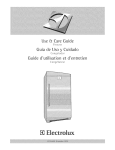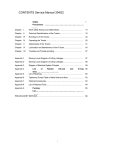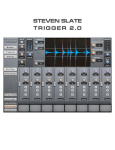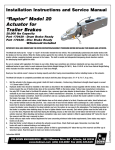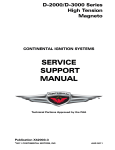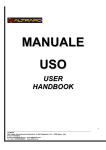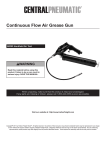Download X43002 - Continental Motors
Transcript
IGNITION SWITCHES STARTER SWITCHES AND DOOR LOCK KITS CONTINENTAL® IGNITION SYSTEMS SERVICE SUPPORT MANUAL Publication X43002-1 © 2011 CONTINENTAL MOTORS, INC. AUG 2011 Supersedure Notice This manual revision replaces the front cover and list of effective pages for Publication Part No. X43002, dated October 1989. Previous editions are obsolete upon release of this manual. Effective Changes for this Manual 0 ............... October 1989 1 ............ 30 August 2011 List of Effective Pages Document Title: Ignition/Starter Switches and Door Lock Kits Service Support Manual Publication Number: X43002-1 Initial Publication Date: October 1989 Page Change Page Change Page Change Page Change Cover............................ 1 A................................... 1 B................................... 1 ii thru vi......................... 0 1 thru 11 ....................... 0 Published and printed in the U.S.A. by Continental Motors, Inc. Available exclusively from the publisher: P.O. Box 90, Mobile, AL 36601 Copyright © 2011 Continental Motors, Inc. All rights reserved. This material may not be reprinted, republished, broadcast, or otherwise altered without the publisher's written permission. This manual is provided without express, statutory, or implied warranties. The publisher will not be held liable for any damages caused by or alleged to be caused by use, misuse, abuse, or misinterpretation of the contents. Content is subject to change without notice. Other products and companies mentioned herein may be trademarks of the respective owners. A Ignition/Starter Switches and Door Lock Kits Service Support Manual 31 August 2011 Intentionally Left Blank WARN (Please note the following statements from FAA Advisory Circular 2 W 2 C entitled "EUGIBIUTY, QUALITY, AND IDENTIFICATION OF APPROVED REPlACEMENTPAKIS): 3. BACKGROUND. An increasingamount of replacement parts (including standard parts), materials, appliances, and instruments are offered for sale as being of aircraft quality when actually the quality and originof these unitsare unknown. Usersofsuch unttsareusuallynot awareof the potentialhazardsinvolved with replacement parts that are not eligible for use on certificated aircraft. Frequently such units are deceptively advertised or presentedas "unused,""iike new," or "remanufactured."lhis impliesthat the quality of such units is equal to an original or appropriately repairedor overhauled unit. The performance rules for replacement of parts and materials used in the maintenance and alteration of U.S. certificated aircraft are specified in FederalAviation Regulations (FAR) 43.13 and FAR 145.57. The responsibilityfor the continued airworthinessof the aircraft, which includes the replacement of parts, is the responsibllityofthe ownerJoperatoras outlined in FAR 91.163, FAR 129.363, FAR 123.45, FAR 127.131 and FAR 135.143 (a). 4. IDENTIFICATIONOF THE APPROVED PARTS. Approved serviceable replacement parts are identified as follows: a. By an FAA Form 8130-3 (Formerly FAA Form 186), Airworthiness Approval Tag. An Airworthiness Approval Tag identifies a part or group of parts that have been approved by authorized FAA representatives. b. By an FAA Technical Standard Order (TSO) number and identiiicationmarkthat indicatesthe part or appliance has been manufacturedunder the requirementsof FAR 37. c. By an FAAlPMAsymbol, together with the manufacturer's name, trademark or symbol, part number, and the make and model of the type certificated product on which the part is eligible for installation, stamped on the part. An FAA Parts ManufacturerApproval (FAAIPMA) is issued under FAR 21.305. The make and model information may be on a tag attachedto the part. d. By shipping ticket, invoice, or other document which provides evidence that the part was produced by a manufacturer holding an FAA Approved Production InspectionSystem issued under FAR 21, Subpart F, or by a manufacturerholding an FAA ProductionCertificateissuedunder FAR 21, Subpart G. e. By a certificate of aiworthiness for export issued by a foreign government under the provisions of FAR 21, Subpart No KNOW YOUR SUPPLIER. lt has come to our attention that many reproduced parts and components, particularly instruments which have been manufactured by persons other than the original manufacturer, are availablefor purchase and installationon U.S. certificatedaircraft. Often, an original part is usedas a sample to produce duplicates. The reproducedpartsappear to be as good as the original part; however, there are many unknown factors to be considered that may not be readily apparent to the purchaser, i.e., heat treating, plating, inspections, tests and calibrations. All too often the faulty part is not discovered until a malfunction or an accident occurs. 2- SUMMARY. In accordance with FAR'S, certification of materials, parts, and appliancesforreturn to servlce, for use on aircraft, is the responsibilityof the person or agency who signs the approval. The owner/operator, as denoted in paragraph 3 of this advisory circular, is responsible for the continued airworthiness of the aircraft. To assure continued safety in aircraft Operation, it is essential that great care be used when inspecting, testing, and determining the acceptability of all parts and materials. Particular caution should be exercised when the identity of materials, parts, and appliances cannot be established or when their origin is in doubt. ii October, 3 989 System Support Manual IGNITIONISTARTER SWITCHES AND DOOR LOCK KITS TABLE OF CONTENTS . . . . . . . . . . . . . . . . . . . . . . . . . . . . . . . . . . . . . . . . . . . . . . . . . . . . . . . . ii INTRODUCTION . . . . . . . . . . . . . . . . . . . . . . . . . . . . . . . . . . . . . . . . . . . . . . . . . . . . iv DESCRIPTION AND OPERATION . . . . . . . . . . . . . . . . . . . . . . . . . . . . . . . . . . . . . . . . . . v DISASSEMBLY . . . . . . . . . . . . . . . . . . . . . . . . . . . . . . . . . . . . . . . . . . . . . . . . . . . . . 1 Disassemble lgnitionlstarter Switches . . . . . . . . . . . . . . . . . . . . . . . . . . . . . . . . . . . . . 1 Disassemble Type GM Switches . . . . . . . . . . . . . . . . . . . . . . . . . . . . . . . . . . . . . . . . 1 Disassemble Door Locks . . . . . . . . . . . . . . . . . . . . . . . . . . . . . . . . . . . . . . . . . . . . . 1 CLEANING AND INSPECTION . . . . . . . . . . . . . . . . . . . . . . . . . . . . . . . . . . . . . . . . . . . . 1 ASSEMBLY . . . . . . . . . . . . . . . . . . . . . . . . . . . . . . . . . . . . . . . . . . . . . . . . . . . . . . . . 2 Assemble IgnitionIStarter Switches . . . . . . . . . . . . . . . . . . . . . . . . . . . . . . . . . . . . . . . 2 Assemble GM Type Switches . . . . . . . . . . . . . . . . . . . . . . . . . . . . . . . . . . . . . . . . . . 2 TESTING . . . . . . . . . . . . . . . . . . . . . . . . . . . . . . . . . . . . . . . . . . . . . . . . . . . . . . . . . 3 Testing Ignitionlstarter Switches . . . . . . . . . . . . . . . . . . . . . . . . . . . . . . . . . . . . . . . . 3 Testing GM Type Switches . . . . . . . . . . . . . . . . . . . . . . . . . . . . . . . . . . . . . . . . . . . . 3 Testing Door Locks . . . . . . . . . . . . . . . . . . . . . . . . . . . . . . . . . . . . . . . . . . . . . . . . 3 WARNING INSTALLATION . . . . . . . . . . . . . . . . . . . . . . . . . . . . . . . . . . . . . . . . . . . . . . . . . . . . .4 ILLUSTRATED PARTS LIST . . . . . . . . . . . . . . . . . . . . . . . . . . . . . . . . . . . . . . . . . . . . . . 5 Equipment Covered . . . . . . . . . . . . . . . . . . . . . . . . . . . . . . . . . . . . . . . . . . . . . . . .5 Ignition Switches . . . . . . . . . . . . . . . . . . . . . . . . . . . . . . . . . . . . . . . . . . . . . . . . . 6 Switch and Door Lock Kits . . . . . . . . . . . . . . . . . . . . . . . . . . . . . . . . . . . . . . . . . . . . 8 Numerical Parts List . . . . . . . . . . . . . . . . . . . . . . . . . . . . . . . . . . . . . . . . . . . . . . . .10 Superseded and Discontinued Items . . . . . . . . . . . . . . . . . . . . . . . . . . . . . . . . . . . . . .ll IgnRionSwitchiLeadingParticulars Rated to handle magneto primary voltage and/or 24 volts DC, 5 amps 1,000 volts DC to ground. Use InsulationTest 11-8950-2High Tension LeadTester Ki. Has removable leverto facilitate Lever Type Switch mounting Has disc tumbler iock with removable Key Type Switch key. Available with matching door locks. 50 hr salt test per Fed. Spec. CorrosionResistance QQ-M-151-A Lubrication CramolinPasteType 20Kd Adjustable for panelthickness to Mounting .312 in. Position Indicating Dial Available as desired 7 02. Weight Housing Die cast Contacts iii October, 1989 System Support Manual IGNITION/STARTER SVVITCWES AND DOOR LOCK KITS INTRODUCTION your localTCM distributor or TCM field representative. Requests for copies of Teledyne Continental Aircraft Engine Service publications should be made through your distributoror Teledyne Continental Motors, P. 0. Box 90, Mobile, AL 36601, Attn: Publications Department. GENERAL A. This manual provides complete maintenance instructions with illustrated parts list for IgnitionIStarter Switches and Door Lock Kis, manufactured by Teledyne Continental Motors, Aircraft Products, Mobile, Alabama 36601. TCM lgnition Switches control magneto operation. Many switches also include con- D. Good standardshop practices and safety precautions trols for starting and eledric primer circuits. Door should be observed at all times to avoid damage to locks are usedto secure cabin doors andlor baggage equipment and or injury to personnel. compartment doors. Switch and door lock kits incorporate matching lock mechanisms and are operated E. All maintenance instructions inthis manualhave been by a single key for maximum convenience. shop verified. Shop verified procedures are those by which the manufacturer has accomplished all DisasB. This manual is subdivided with sub-heads as listed in sembly, Assembly, Testingand Fault Isolationby perthe Table of Contents. Revision service may be proforming the functions described in this manual on vided by ordering Master Service Manual Form equipment identical in configurationto that described. X40000. TCM Ignition Systems Service Bulletins includedin Master Sewice Manualprovidecurrent infor- F. Dimensions are given in Standard Units. For refermation related to service, maintenance and technical ence, abbreviations used are listed in Table 1. support of the product. Service Bulletins 583 and 615 have been incorporated intothis manual. This manual G. Numbers in parentheses following part nomqnclature refer to item numbers in illustrated Parts Llst Figure 1 may be includedin Chapter 74-30of applicableGAMA format publications. and 2 unless otherwise specified. Example: (1-5) is item 5 in IPL Figure 1;(2-1) is item 1 in IPL Figure 2. C. These instructionsdo not cover all details or variations in equipment nor do they provide for every possible Recommendations, cautions and warnings regarding contingency to be met in connection with installation, maintenanceof this equipment are not intendedto impose operation, or maintenance. Shouldfurther information undue restrictions. They are inserted to obtain maximum be desired or particular problems arise which are not performancefromthe equipment in accordance with safety covered sufficiently for purchaser's purpose, contact and efficiency. Abuse, misuse, or neglect of any piece of equipment can cause eventual failure. For an aircraft enTable 1 gine it is obvious that a failure may have disastrous conseAbbreviations quences. Failure to observe the instructions contained in this manual constitutes unauthorized operation in areas unexplored during development of the engine, or in areas in which experience has proved to be undesirable or detrimental. Pound Inches lb in. NOTES, CAtmONS and WARNINGS are included Pound Fource Ibf throughout this manual. Application is as follows: I II I I Pounds per Hour PPh 1 NOTE. ..Special interest informationwhich may facilitate the operation of equipment. I Pounds per Square InchGage Psis I CAUTION. . . lnformation issued to emphasize certain imtructions or to prevent possible damage to engine or accessories. I I Gallons ft gal II I ounces oz I Feet iv October, 1989 .. Information which, If disregarded, rnay result insevere damageto or destnrctionof the engine or endangementto personnet. WARNING. System Support Manual IGNITIONISTARTER SWITCHES AND DOOR LOCK KITS DESCRIPTION AND OPERATION GENERAL Twist to Start A. With 2 Keys 10357200-1 Ignition switches manufactured by Teledyne Continental Motors, Aircraft Products, Mobile, Alabama 36601 are designed to provide control of magneto operation. Optional starter solenoid control, electrical primer control, and key or lever designs are available as shown in Figure 1. 10357200112 with 2 Cessna Keys 10357230-1 Lwer Type B. The various switch position functions are listed 10357BO-1 Lever Type, without Lever below*. OFF Both magnetos inoperative R Right magneto operating Left magneto inoperative Push to start 10357210-1 with 2 Keys L BOTH Left Magneto operating Right magneto inoperative 1 0357210-9 with 3 Keys Both magnetos operative 10-357240-1 Lever Type START Battery terminal connected to starter solenoid through start terminal. Rlght magnet0 may be grounded with jumper behnreen right terminals. Left magneto main and retard contacts may be connected to starting vibrator output. Spring return to both position. Twist to Start Push to Prime PUSHTOPRIME Allows aircraft to be electrically primed either in BOTHor START position. Spring loaded to normally open circuit position. 10-357220-1 with 2 Keys 10357250-1 Lever Type C. Typical ignition switch mounting dimensions are shown in Figure 2. Dimensions are in inches. 10357290-1 with 2 Keys 10357290-13 I Figure 2. S w k h Dimensions with 2 Cessna Keys Figure 1. Switch Functions V October, 1989 System Support Manual IGNITION/STARTER SWITCHES AND DOOR LOCK KITS D. Ignitionswitch placard indicator dials are available for each type of switch. E. Door locks are supplied in kiis as listed in Illustrated Parts List. Door locks supplied with key-actuated switches are actuated by the same key. Door locks listed in Illustrated Parts List are also available separately and, when purchased this way, will have their own key. If a door lock or switch becomes damaged, a new one may be purchased separately. Key PK number stamped in this area. MAINTENANCE RECOMMENDATIONS A. Ignition switch maintenance is conducted on an oncondition basis. Whenever access allows, components should be inspected for positive operation, wear, binding, looseness or burning. Replace components as necessary. 8. For key operated switches, due to the danger of removing the key from the switch in other than the I "OFF" position, switch locks (1-20) utilizing keys marked with PK number code listed inTable 2 marked as shown in Figure3 should be removedand replaced C. at customer's earliest convenience. If key is not marked with PK number code, refer to outside face of any matching door locks. Table 2 PK-502. 525, 553, PK-605, 643, PK-722, 755, 777, PK-800, 860, 887. PK-901, 967, 503, 528, 563, 606, 646, 729, 756, 784, 805, 862, 889, 914, 968, K N PK NUMBER CODES 504, 506, 507, 511, 512, 513, 530, 532, 533, 536, 537, 539, 565, 572, 573 613, 616, 617, 618, 627, 639, 648, 650, 653, 657, 660, 667, 731, 734, 735, 736, 738, 743, 758, 760, 763, 765, 766, 767, 786, 798 807, 814, 846, 848, 850, 852, 869, 872, 873, 876, 880, 881, 890, 891, 894 916, 921, 922, 923, 930, 956, 970, 971, 978, 985, 990, 992, p d)-- '~emoveMack rubber from top of key to expose the PK number. Figure 3. PK Number Location For all switches with start position, to ensure positive grounding of magnetos when in "OFF" position, old support (1-2) shoud be replaced with current design support (1-2) at customer's earliest conveneince. Current design support includes oversize rivet head as shown in Figure 4. Current support (1-2) is identified with white paint mark on terminal lug side of support. 523, 524, 544, 551, 641, 642, 682 744, 745, 773, 774, .22 in dia. 853, 855, 882, 884, 963, 966, 996, 997, Figure 4. Current Support (1-2) IgnitionIStarter Switches vi October, 1989 1 System Support Manual IGNITIONISTARTER SWITCHES AND DOOR LOCK KITS MAINTENANCE INSTRUCTIONS DISASSEMBLY NOTE: I( Complete disassembly is not necessary in all instances. Only disassemble switch to the extent necessaryfor repairs. A. C. Locks Do not attempt disassembly of door locks. CLEANING AND INSPECTION A. Clean all switch partsthoroughly with trichlorethylene or other suitable solvent. B. (1) On switches which incorporate a lever, remove lever (1-15) by removing screw (1-13) and lockwasher (1-14) from shaft (1-18). Remove nut (1-16 or 1-17) and dial (1-22) if used. Remove switch from panel and remove all wires from switch terminals. (On key actuated switches C. begin disassembly with removal of nut (1-16 or 1-17) and dial (1-22) if used.) Inspect switch rotor (1-7) and contact support (1-2, 1-2a) for cracks and check contact surfaces for grooves or excessive wear. Inspect switch contact bracket (1-9) and switch contacts (1-3, 1-3a) for excessive wear, corrosion or deformation. Disassemble IgnitionIStaiterSwitches: lnspect lock assembly and key (1-20) for wear. When key is inserted,the brasstumblers should beflushwith barrel. Small extensions may be filed off, or a new key may correct this condition. (2) Remove self-tapping screws (1-1) and pull off support (1-2). Take out switch contacts (1-3) and D. Ifpositioningspring, which is in switch housing (1-21), spring (1-4). Remove self-tapping screw (1-1), is broken, has weak spring tension or shows signs of lockwasher 41-5) and plain washer (1-6) from considerablewear, replace switch housing (1-21). center of rotor (1-7). (3) Removelockassembly (1-20) or shaft (1-18)from front of switch. Pull rotor (1-7) from housing (121). L i spring (1-11) and retainer (1-12) from rotor (1-7). (4) The 10-357210 series switches incorporate a bushing (1-19) on end of lock assembly. Slide bushing from end of this assembly. (5) If used, pull pin (1-8) from rotor (1-7). Remove bracket (1-9) and spring (1-10,1-1 Oa). B. DisassembleType GM Switches(10-357290Series): (1) Remove knurled nut (1-16) and dial (1-22) from switch. Remove switch from panel and disconnect wires fromterminalsby removingnuts (1-28) and lockwashers (1-5a). Remove hex nut (1-17). Remove two screws (1-1) which secure switch contact support (1-2) to housing (1-21). Lift two contact brackets (1-9) and coil springs (1-10a) from switch rotor (1-7a). Remove screw (1-I), lock washer (1-5a) and flat washer (1-6a) which secure rotor (1-7a) to switch lock assembly (120). Switch lock assembly can now be removed from the housing. I 1 October,1989 System Support Manual IGNITIONISTARTER SWITCHES AND DOOR LOCK KITS B. ASSEMBLY NOTE: (1) Assemble contacts (1-3a, 1-3b), screws (1-25, 1-26), washers (1-27,16a) and nuts (1-28) onto support (1-2a). Apply 8-11 Ib. in. torque to each inner nut (1-28). During assembly, sparingly apply Cramolin paste type 20Kd* to contact (1-3) face, to bracket (1-9) contact surfaces and to contact side of support (1-2,I-2a) assemblies. A dab of this paste may also be applied to positioning spring in housing (1-21) and to lock (1-20) key teeth. A. Assemble GM Type Switches (2) Align rotor (1-7a) in housing (1-21) as shown in Figure 5. Seat rotor (1-7a) completely into housing (1-21). Assemble IgnitionlStarterSwitches I (1) If used, assemblespring (1-10),bracket (1-9)and pin (1-8) into rotor (1-7). (3) Insert bck plug (1-20) into rotor (1-7a) and assemble screw (1-I), lock washer (1-5a) and washer (1-6a) into rotor (1-7a) and lock plug c;POSITIONING SPRING (2) Assemble radial tang of spring (1-11) into rotor (1-7) groove. (3) Assemble spring retainer (1-12) hole onto axial tang of spring (1-11) with boss on retainer (1-12) towards rotor (1-7). Wind retainer (1-12) counterclockwise until retainer arm rests in recess in rotor (1-7). (4) Orient rotor (1-7) assembly so ridged portion I aligns with positioning spring in housing (1-21). Referto Figure 5. Seat rotor (1-7) completely into housing(1-21). Figure 5. Proper Positioning of Rotor (1-20) tighten and adjust screw (1-1) to allow no binding during switch operation and minimal end play. If this is not possible, replace lock plug (1-20). - (5) Assemble bushing (1-19) (if used), lock plug (1 20) or shaft (1-18) into housing (1-21) and rotor (1-7) assembly. Chamfered edges on iock plug (1-20) and shaft (1-18) allow parts to be assembled only one way. During assembly, support rotor (1-7) with fingers to prevent pushing it back out of housing (1-21). Assemble washer (1-6), lockwasher (1-5) and screw (1-1) into rotor (1-7) and lock plug (1-20) or shaft (1-18). Tighten and adjust screw (1-1) to allow no binding during switch operation and minimal end play. If this is not possible, replace lock plug (1-20) or shaft (1-18). (4) Assemble springs (1-1Oa) and brackets (1-9) into rotor (1-7a). Brackets(1-9) should slidefreely into and out of rotor (1-7a) and should be aligned as shown in Figure 5. (5) Align boss on support (1-2a) with notch in housing (1-21) and assemble with two screws (1-1). (6) Test switch in accordance with Testing procedures. (6) Insert springs (1-4) into recesses in rotor (1-7). Assemble contacts (1-3) onto springs (1-4). Align boss in support (1-2) with notch in housing (1-21) and assemble with two screws (1-1). (7) Test witch in accordance with Testing procedures. I "CramdinPaste Type 20Kd available in 1 oz. can,Catalog No. P-200-K1,tom Caig Laboratwies, 17750 lndusfriai Ave. (P. 0.Box J), Escondido, CA 920250051. I System Support Manual IGNITIONISTARTER SWITCHES AND DOOR LOCK KITS TESTING B. GENERAL: Following assembly, test switch for positive operation. Action must be smooth, without sticking. Keys must be removable in only the "OFF position. Test switch electrical operation as described in paragraph A and B below. If switch fails tests, check for incorrect assembly or bent.. C. switch contact brackets. A. Testing GM Type Switches (1) Using 11-8950-2 tester or equivalent, check for continuity as shown in Table 4. (2) Perform high voltage insulation test as described in paragraph A(2) above. Replacedoor lock or key if lock binds during operation or if key is removable in intermediate positions. Testing lgnitionlstarter Switch (1) Using the 11-8950-2 Tester or equivalent, check for continuity between each terminal and all other terminals, and between each terminal and housing, in all switch positions. Table 3 indicates terminals which shall have continuity. If there is continuity between any other terminals and/or housing, the switch shall be rejected. It is not necessary to check continuity between the two terminals at R. NOTE: Table 4. GM Type Switch Logic Lower "R"terminal is grounded in start position. See Figure G. (2) Using the 11-8950-2 Tester or equivalent, make a highvoltage test of insulationresistance between each terminal and all others that are open circuited, and between each terminal and housing in all switch positions. NOTE: Unless switch is push-to-prime type, PR terminal is not used. (Push to Prime) L and GRD R and GRD BAT and S; R and GRD; L, LR and BO Table 3. IgnitionlStarter Switch Logic 3 October, 1989 System Support Manual IGNITIONISTARTER SWITCHES AND DOOR LOCK KITS INSTALLAVON A. B. Using the pertinent illustration in Figure 6, conned wires to their proper terminals using screws (1-24) or nuts and lock washers (1-28,l-5a). If right magneto is to be grounded during start, attach lug terminal (1-23) C. across terminals nearestthe "R" mark. Connectionsto the terminals are as follows: GRD R L LR BO S BAT PR Ground Right Magneto "P" Lead Left Magneto "P" Lead Left Magneto Retard Lead Booster Output (Starting Vibrator) Starter Solenoid Battery Primer Solenoid (Used only on switches with "pushto prime"feature incorporated.) TWIST-TO-START AND PUSH-TO-PRIME TYPES PUSH-TO-START TYPE USH-TO-START Figure 6. Switch Terminal Locations 4 October, 1989 Lever (1-15) must be removed prior to installation of lever type switches. To remove lever (1-15), remove screw (1-13) and lock washer (1-14) and pull lever (1-15) straight off. Following lever removal, installation procedures for lever and key type are the same. The switches are installed from the rear of panel through a 15/16 inch hole with an alignment lug which fits in groove in switch housing. Recommended maximum panel thickness is 0.31 2 inches. D. Removeknurled nut (1-16), and seat hex nut (1-17) as close as possible to switch housing (1-21). E. Insert switch assembly through hole in panel with keyway in switch aligned with lug. If it is desirable to install a position indicating dial (1-22) it must be in stalled over and aligned with the keyway in the threaded end of housing extendingfrom controlpanel. F. Tighten round knurled nut (1-16) over threaded portion of switch. If possible secure switch firmly in place by tightening hex nut (1-17) against rear of panel. Complete assembly is shown in Figure 7. System Support Manual IGNITION/STARTER SWITCHES AND DOOR LOCK KITS IGN~ION$WITCHES IGNITION SWITCH AND DOOR LOCK KlTS DOOR LOCK KlTS IPL TABLE 1: EQUIPMENT COVERED See Descttptfon Part NO. IPL Fig. No. Keys Switch Only, Key Type, Twist to Start Switch and Door Lock Kit Switch and Door LockKi Switch Only, Key Type, Twist to Start Switch and Door Lock Kit Switch and Door Lock Kit Switch and Door Lock Ki Switch and Door Lock Ki Switch and Door Lock Kit Switch and Door Lock Kit Switch Only, Key Type, Pushto Start Switch Only, Key Type, Pushto Start Switch and Door Lock Ki Switch and Door Lock Ki Swich and Door Lock Ki Switch and Door Lock Kit Switch Only, Key Type, Twist to Start, Pushto Prime Switch Only, LeverType, Twist to Start Switch Only, Lever Type, Pushto Start Switch Only, Lever Type, Twist to Start, Push to Prime Switch Only, Lever Type (Wihout Lever), Twist to Start Switch Only, Key Type, GM (No Start Position) Switch and Door Lock Kit Switch and Door Lock Ki Switch and Door Lock Ki Switch Only, Key Type, GM (No Start Position) Door Lock Ki Door Lock Kit Door Lock Ki * Keysmarked"CESSNA" 5 October, 1989 System Support Manual IGNITION/STARTER SWITCHES AND DOOR LOCK KITS IPL TABLE 2: IGNITION SWITCHES 6 October, 1989 1 ITEMS 25 THROUGH 5a (QTY 6) INCLUDED WITH KEM 2a * NOT AVAILABLE AS A SPARE. SHOULD REPLACEMENT BE NECESSARY, REPLACE ENTIRE SWITCH. ** DIAL NOT SUPPLIED WITH SWITCH, PURCHASE SEPARATELY AS INDICATED. System Support Manual IGNITION/STARTER SWITCHES AND DOOR LOCK KITS IPL Figure t. Exploded View of Switches 7 October, 1989 System Support Manual IGNITIONISTARTER SWITCHES AND DOOR LOCK KITS IPL TABLE 3. IGNITION SWITCH AND DOOR LOCK KITS " Keys marked "CESSNA" " Dial not supplied with kit 8 October, 1989 System Support Manual IGNITIONISTARTER SWITCHES AND DOOR LOCK KITS IPL Figure 2. Ignition Switch and Door Lock Kits 9 October, 1989 System Supporl Manual IGNITIONISTARTER SWITCHES AND DOOR LOCK KITS IPL TABLE 4. IGNITION SWITCH AND DOOR LOCK KITS NUMERICAL PARTS LIST Part Number 10-377028 10 October, 1989 Nomenclature support Dial Screw and Lock Washer Terminal -Lug Screw Dial (Twist to Start) Dial (Twist to StarVPushto Prime) Dial (Push to Start) Door Lock and 2 Keys Door Lock and 2 Keys Support Kit Support Kit Door Lock and 2 Keys Door Lock and 2 Keys Door Lock and 2 Keys Door Lock and 2 Keys Door Lock and 2 Keys Figureand Item No. 2-3f System Support Manual IGNITION/STARTER SWITCHES AND DOOR LOCK KITS IPL TABLE 5: SUPERSEDED AND DISCONTINUED ITEMS OLD PIN 10-32890-1 10-34365 10-51104 10-51104-1 10-51150-1 10-51150-2 10-51160 10-51180-1 10-81388-1 10-126630-1 10-126630-4 10-126660-1 10-126660-4 10-126680-1 10-126680-2 10-126680-6 10-126690-1 10-126690-2 10-126690-4 10-126690-6 10-126690-8 10-126690-11 10-126690-12 10-126690-13 10-126690-14 10-126690-15 10-157440-1 10-157440-2 10-157440-3 10-1574404 10-757440-21 10-357200-2 10-357200-3 10-357200-4 10-357200-5 10-357200-6 10-357200-7 10-357200-8 10-357200-9 10-357200-13 10-357200-14 10-357200-15 10-357200-16 10-357200-17 SUPERSEDEDBY 4 t t 10-357290-1 t t t t 10-357230-1 t 10-357250-1 t 10-357220-1 10-357210-1 t 10-357200-1 Supetseding PlFI may be supplied upon request. t t t t * t t * t t t * t t * * * t t t t t * * OLD P/N 10-357200-19 10-357200-21 10-357210-2 10-357210-3 10-357210-4 10-357210-5 10-357210-6 10-357210-7 10-357210-8 10-357210-11 10-357230-2 10-357260-2 10-357260-3 10-357260-4 10-357260-5 10-357260-6 10-357260-7 10-357270-1 10-357270-2 10-357270-3 10-357270-4 10-357270-5 10-357270-6 10-357270-7 10-3572708 10-357270-9 10-357270-10 10-357270-11 10-357280-1 10-357280-2 10-357290-2 10-357290-3 10-357290-4 10-357290-5 10-357290-6 10-357290-7 10-357290-11 10-357290-14 10-357290-15 10-357290-16 10-357310-1 10-357310-2 10-357310-3 10-357310-4 10-357310-5 SUPERSEDEDBY t t t t t t * t t .c * t t * t t t t t t t t t t t t t t t t t t t t t t t t t t t 11 October, 1989 www.continentalmotors.aero




















